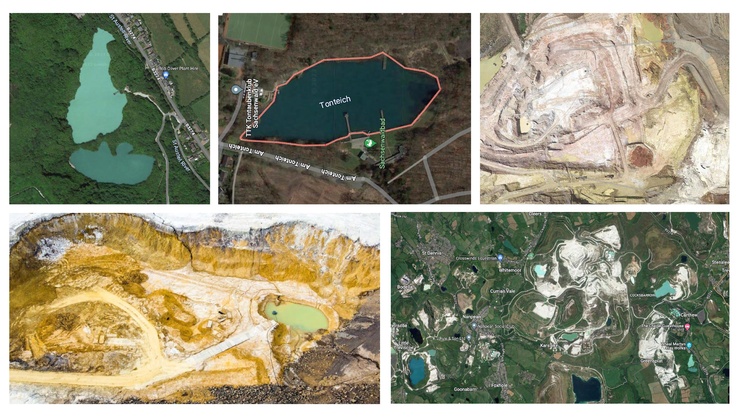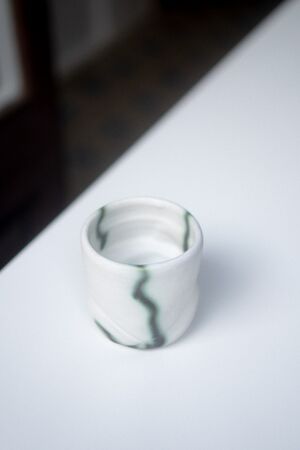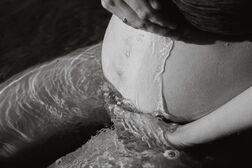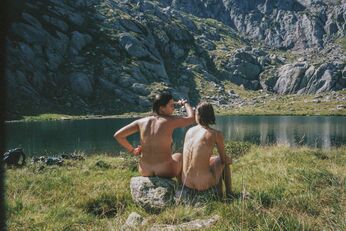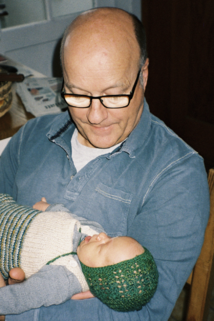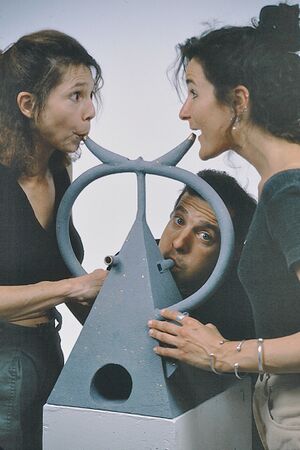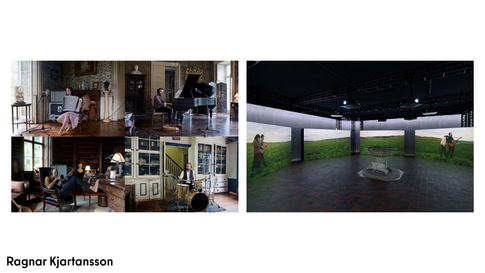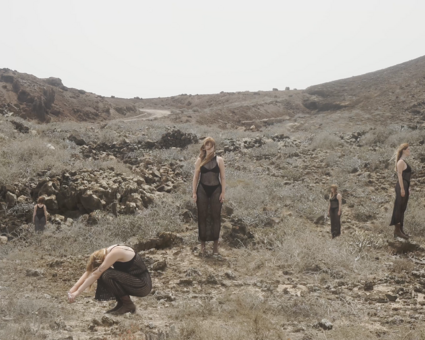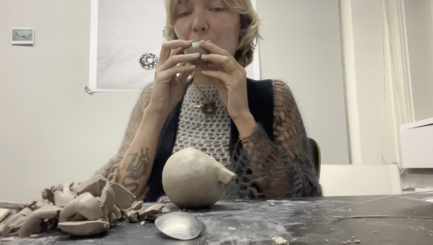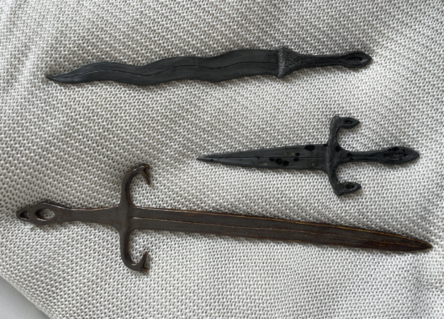Clara Thesis Outline & Proposal"
BODIES OF WATER
THESIS OUTLINE
Introduction
Body of Water
Fill the abyss we have left
Order’s returning
A solarpunk view on the relationship between clay(mining) and humanity.
A conversation with the matter which hosts at least 30% of us in houses of brick and cob, and which has been my growing obsession.
Aiming to visualize and unravel the complexity of clay mining and usage, I am creating ceramic instruments as a research medium.
On the one hand extracted, reshaped, burned, it is impossible to return clay into it’s natural form.
On the other hand clay quarries leave behind an abyss. Borrow pits then often fill with water, turn into excavation lakes, turn into wildlife habitats and are used for recreational human entertainment.
A calming thought experiment of nature returning no matter how much our species may take from it.
The following short stories are a collection of personal memories, observations and findings that were inspired by or have inspired this process.
Two Solar Punks part 1
We are standing close to the check-in of the boulder gym with its view onto a slightly sad looking canal, especially in this season. Next to me is one of my dearest friends.
We both grew up in Hamburg's suburbia and decided to study in the small student town of Groningen in the Netherlands. As a teenager I loved him in a romantic way, but eventually found out that he is not romantically interested in females, so the attraction switched to a different kind of love.
We are waiting for someone he has recently met here and will join us today. A blond man, well boy, whatever one is in the early twenties, enters. He is wearing a relatively snug fitting brown leather jacket with a fur collar. There is something slightly arrogant about him I think to myself. He smiles and my judgemental opinion changes immediately while I nervously drop my cards on the floor next to the counter. He helps me pick them up and we introduce ourselves.
He is a good hugger.
Two Solar Punks part 2
I don’t know what I would have thought that day if someone would have told me that after a year of friendship and him helping her through another heartbreak, these two will spend 3 years of their lives together.
Sal would be the one to switch between ecstatic excitement about utopias, in which we would live in a community in the Italian mountains, build a cob house and grow microgreens and mushrooms, and a dystopian luring climate anxiety, constantly confronted with the inescapable destructive systems we grew up in and the secret craving for a predictable, stable life and income.
I would say we made a picture perfect, cliche-neo-hippie couple. Both long haired blondies, intensive travelers, opening and closing our relationship, strong value sets, vegetarian, and not to forget to finish off hippie cliches; white and from a privileged background. Our lives were contradictory in itself, preaching about sustainable living while flying to Cape Town to visit friends and the Burning Man Festival in the middle of the South African desert, also an almost entirely white event.
The solutions to almost all global issues seemed obvious to us; universal basic income, community housing, local produce…
Stubborn as I am I would not want to agree with his sometimes exaggerated statements and slightly falsely stated facts to underline his points. But behind that reflex of stubborn disagreement, I did agree almost always to his core points.
We both aligned in the way we would like to imagine the world and a future in which nature, humans and technology can sustainably coexist and interact, and in which we can live a fulfilled, happy life surrounded by those we love.
We were and will be solarpunks at heart.
Homes of Red Brick
She grew up in a suburbia shaped from red brick houses hosting 2 perfectly normed, nuclear family constellations at a time.
She moved into a red brick house hosting 250 humans challenging these norms.
She moved into a red brick house with two other artists, tedious mice, pigeons that would release themselves in her room when the door would be left open and moths nibbling on her woolen clothing.
She despises the color red more than anyone she ever met.
Lessons from Ceramics
Immersing my hands in the soft body of soil, I forget about the concept of time until my back painfully reminds me of the duration of my doing.
I intuitively stroke the material until the desired smoothness of the surface and shape is achieved. An extension of my own body and mind, each object recognisable as my hands’ collaboration with the natural material.
I started working with clay during the last year of my undergraduate degree at the Minerva Art Academy in Groningen. Making and failing plenty, my usually impatient self would be pinned to the ceramics studio for many hours at a time.
The small room almost hidden behind the cantine hadn't really caught my attention in the 3 years leading up to this point, possibly due to the dislike of the oddly unmotivated tutor that some of my friends were expressing.
Not exactly sure what switched, but once I started I never stopped and became increasingly obsessed.
I went on to take a turntable course in Barcelona, impatiently waiting until I could go back to my class in Gràcia, a lively neighborhood towards the mountains. The class was led by the calm handed, attractive, tattooed teacher Antonio, his music choice always hitting the spot. It started by watching him in the almost sensual act of centering a 500 gram piece of clay, a slurping soundscape while continuously changing the shape from a phallic tower to a flat blob. Once I was able to center and pull up the walls of a vessel with his help, it was time to wait until the piece was, what is called, leather hard.
“Un poco más!” Would be one of his typical comments in the next step of the process; trimming. Tapping on the shape I was working on, he was listening to the sound of the hollow body. Once the sound became drum-like, hollow, it was time to stop cutting down and leave the little creation to dry and wait for its next step.
Baking, glazing, baking, and after 4 weeks in total I would finally hold my first own cups. Oh, the joy. Of course every piece but one would be gifted proudly to family members for Christmas a month later.
That last one, my favorite, was a cup accidentally twirled around by the spinning table. A beautifully accidental, asymmetrical mistake, reminding me of its organic origin and handmade qualities.
Back in the Netherlands, I once glazed 20 cups accidentally with non-water resistant glaze for my friend’s coffee shop. I continued learning a lot and 1 year later built up the courage to pick up the molding cups again to try to reglaze them, scared that the weeks it took me to create them were for nothing after all. But I managed!
Glaze stuck to the kiln, completely melted pieces that I accidentally put in the wrong temperature kiln and many more mistakes would follow. Many explainable, many frustrating, but all full of lessons.
More cups, vases, plates, swords, crowns, and now instruments became part of my proud collection of ceramic creations. I can hardly use a mass produced ceramic piece with pleasure anymore, knowing the bliss I feel when holding one made with my, my friends or my sisters hands.
It feels addictive, the workshop luring me in every time I pass it on the second floor of our university.
A playground where knowledge exchange is the norm between all playmates.
Collectively understanding the matter in greater detail every time. Running into my fellow students Bart and Laura-Lize I can usually expect a new experiment with natural glazing they have just done being explained and shown to me with glowing, child-like excitement in their eyes.
It is never about showing off, it is always coming from that excited playfulness and the knowing that the other will feel the same and exchange volcanic rocks powder, ashes, found soil and other toys back.
An odd combination of productiveness, which I crave in a partially unhealthy amount, mixed with a meditative sense and yet a feeling of procrastination, not knowing why I exactly keep creating artifacts, that the world definitely is not in great need of.
The more I read the more I understand the import and various role clay has played for humanity. We have used it to build housing, create instruments, create vessels for our food, create beautiful sculptures, apply it on our bodies as masks or even eat it (German Heilerde or Kyrgyz Gulboto).
Always feeling that there is more to tell with this practice other than simply creating beautiful objects and gifts for my loved ones, this project is an aim to explore the potential of clay to truly interact with its origin.
´
Lessons from Lakes
Growing up in Hamburg's suburb Bergedorf, many summer days were spent and winter dips taken at its various lakes that were within cycling distance of my parents house.
I generally am a person who enjoys immersing themselves in water in moments of flaring up anxiety. A dip into a body of water almost guarantees to calm my racing heart and intrusive thoughts. Most chances I get I aim to motivate to leave closing behind and sprint into waters encountered. One of the most freeing, bonding, calming, exciting things I can imagine is a swim in beloved company.
In July of this year my sister and I went to the one closest to our childhood home to take photos of her as she was pregnant with her daughter Svea.
Watching and photographing my pregnant, naked sister, she started washing her belly with the water we were once bathed in as toddlers.
Then she started singing, not knowing that I was now actually filming her serenading her unborn child.
Half a year later I am revisiting this beautiful memory, with new information added to the context; This lake is actually a remnant of human extraction. The excavation lake was created between 1978 and 1982, when sand was needed for the extension of a closeby highway. Then the low ground water of Bergedorf filled it to become what is now the See(lake) Hinterm Horn.
Also all of the other lakes in this area that have shaped so many of my childhood memories have a similar history. The Boberger See and Eichbaumsee are past sand pits. Then there is one, that my father spent many of his childhood days at, as he grew up in the same area of the city; the Tonteich- Clay Lake. This lake formed after the local brickyard opened in 1875 and started extracting clay here. The factory burned down and never reopened, but the borrow pit stayed and slowly filled with water over the years.
One interesting fact here is the acidity of the water, as the clay bed of the lake created a scenery, that is not inhabitable for many fish and mosquitos for example.
I continued searching for the history of the lakes I have been visiting most in Germany and the Netherlands, realizing that almost all of them are excavation lakes; residues of surface mining.
Along my deep dive I sent an email to the company Goerg & Schneider, which is the company that has supplied our school with clay. On their website they mention the act of recultivation and how the process of clay extraction can be done in the most reciprocal way.
But how sustainable and reciprocal can a process be when something is taken that can not be returned?
The duality of this topic becomes more and more present.
Ultimately I wish to unravel the emotional disconnect that has grown between consumers and goods. My aim is to promote ideas of a symbiocene, a reciprocal relationship between humans and the land we inhabit, in which nature will ultimately outlive ourselves and we will become part of it ourselves again, once our bodies disintegrate into soil.
Bodies of Water
Our bodies of water
jump into
a body of water
turns into
bodies of water
jump into
a body of water.
Life’s like a confusing swimming lesson, with winds between 0-100mph and occasional water up the nose
I bathe in the resonating sound of his deep voice, unable to respond.
I bathe in melodies, intoxicated and surrounded by alienated, yet oddly connected bodies.
I bathe my naked body in an icy stream, who directly made its way from the mountains, stopping my breath for a second.
I bathe in the giggles shared with friends, allowing each other to make increasingly inappropriate jokes throughout the evening.
I bathe in your hug, wanting to request another one as soon as we let go of the embrace.
Go with the waves of your emotions, my therapist said.
Life’s like a confusing swimming lesson, with winds between 0-100mph and occasional water up the nose.
Lessons from lullabies
A dramatic scream for help, followed by rhythmic bouncing of the little body combined with a calming humming or lullaby, possibly for both sides to cope with the outburst of emotions.
Her sister recently gave birth to a little girl called Svea, so she began observing family members humming and singing to this little creature to calm her down. Making up their own songs and melodies, that by repetition seem to work more and more. A beautiful reminder of the soothing power of our voices and melody in general.
She came from a musical family, in which it is normal to sing songs on Christmas day in 4-part harmony (not to the excitement of all 10 cousins) and have jam sessions and choir rehearsals in our living room. A room hosting probably 100 instruments, a playground which she sadly only started to appreciate after she moved out.
Her sister recently became a certified music therapist and the mother spend much of her free time drumming in a percussion group on the side of local protests, practicing with her folk music band or conducting a choir that she had started almost 30 years ago. Her father and aunt were members as well and she loved listening to her father practicing the bassline of the choir songs.
In her parents house one will often hear a humming or whistling melody, coming from the vocal cords of her father. Melodies, sometimes familiar, sometimes seemingly random.
The sisters had been observing this behavior with the assumptious conclusion that this is his way of relieving stress too.
Recently on the phone, her mama stated: “if I wouldn't make music in these times, I think I would be an addict. I would be drinking, I would take drugs.” This woman has never touched drugs, except for alcohol and nicotine in her life. And even if she might be slightly over exaggerating, you get the point.
So basically she had plenty of examples in my family for how musical experiences could be used in various ways to soothe and connect to each other. Not just the hippies understood music as a medium to strengthen political movements through music and build a community based on pacifistic ideals.
When words don’t do justice anymore, the internationally understood language of music can decrease blood pressure almost unnoticed with its vibrations.
She leaves her front door, takes her phone from her pocket, puts on a song, puts in her headphones and starts cycling, singing loudly for herself and whoever she passes on her way.
Bodies of water streaming in the lake
Cleaning all the tension that needed to be left behind
Take a deep breath in and fill yourself with elements
Elements of how we’ve been created and will decompose
Back into these bodies of water
clean yourself with water
Let the elements make you drift away
Drift away into body of water
Become the body of water as you become one with where you come from and what you once will be again
Sweet dreams of pleasant streams
Mermaids
They hadn't been together for a short while now, but couldn't fully let go of what they lost yet with a slight hope and confusion, that it might not actually be over yet.
So they plan a sleepover on the beach on a late summer evening, stopping at a gas station to buy wood for a fire.
He had the tendency to misjudge directions and distances and trying to not fall back into her unfair patterns of bickering she retained her joking tone while they accidentally walked in circles with their heavy bags through a small forest to the dunes.
It took longer than he would have thought to start the fire too, but ripped out pages of her notebook helped.
The fire still burning they ran into the cold sea, luminescent algae glowing up shyly around them. “It was so much stronger two days ago”, he said.
She had only seen luminescent algae once before in her life, but would have never expected it in this usually quite unexciting country. She takes another slow dive through the little sparks of light and starts whirling her hand around the water, almost as if trying to whip it like egg white for a meringue.
They spend the rest of the evening side by side by the fire, eating risotto he cooked the day before and exchanging music they have been listening to since they broke up.
It starts raining, so they decide to go home instead of sleeping in the dunes, as they had planned at first.
When they come home she grabs the guitar, and starts singing along to the sound of the strings. “I love listening to you sing”, he said, rolled up on the couch next to her.
PROPOSAL
A musical collaborative performance with ceramic instruments
What?
I will create two video pieces and an interactive installation that center around a ceramic musical altar.
The first short film of approximately 5-10 minutes will be documenting the creation of ceramic instruments from the extraction of the clay, to the shaping, burning, glazing and final instruments.
The second video will be a one-shot performative short film of approximately 15 minutes in which the instruments will be used by myself and another musician on the location where the clay has been extracted. This film will center around a “musical altar” consisting of the self made ceramic instruments.
Lastly the ceramic piece itself will be exhibited, so it can be interacted with by the visitors.
Here are some visual insights into my search for references and my first try outs.
How?
Step 0: Continue reading in different directions such as object oriented ontology and examples for reciprocal relationships between humans and land (Currently reading Braiding Sweetgrass by Robin Wall Kimmerer) in order to specify my research.
Step 1: Make ceramic instrument trials. Possible instruments include; flute, marimba/xylophone, hanging plates/chimes, shaker, bells, water whistle, drum, guiro. I will document the process through film and photography. Film this whole process
Step 2: Start collecting clay and try to create instruments with such. Also film this whole process.
Step 3: Create video performances in collaboration with my close friend and collaborator in many ways Mila. This can be filmed in a location where I collected clay.
Step 4: Possibly create one meditative loop song that I will create a music video to.
Why do you want to make it?
Coming from a multidisciplinary background I have devised a way to combine my interests and skills in lens based work, ceramics, and musical performance.
One of my learnings of the past 5 years spend in art school has been the appreciation of objects from the perspective of a crafter, understanding and appreciating the virgin material and the path it had to take in order to take on a new shape and be usable to humans.
This project gives me the chance to visualise this process of gratitude focussed production methods, with an underlying anti-capitalistic thought, as it visualises the emotional disconnect that has grown between consumers and goods. My aim is to promote ideas of a symbiocene and reciprocal relationships between humans and the land we inhabit.
The musical part of this project comes from many influences throughout my upbringing in a very musical family and my ongoing collaborations as a lens based artist with musicians, as right now with my friend Mila Meijer. Together we are currently producing several music videos for the EP of the duo MIEL that she is part of. As this project in currently ongoing next to my studies and I am greatly enjoying working with her it felt natural to bring her influence on me into this project as well.
Having felt very touched by Ragnar Kjartansson's works "The Visitors" and "Death is Elsewhere", the want to include a musical aspect to my graduation project became stronger.
Who can help you?
Musically I will have support through my sister(music therapist) and mama(choir conductor) and my friend Mila(musician and frequent collaborator).
When it comes to ceramics, I am reaching out to two fellow WDKA students; Laura, who is learning a lot about natural glazes at the moment and Dori, who is already working with ceramic instruments. I am also reaching out to artists that work with clay that they have collected themselves. The potterer Claußen in Brunsbüttel works with clay out of the Wadden sea and the recent WDKA graduate Rink Schelling works with clay from Zeeland.
I am also planning to visit the Soundlab at the ceramics center EKWC, close to Tilburg. Possibly support can be found there.
Relationship to previous practice
These applied disciplines have been in my practice for some time. I grew up in a very musical family and embraced my inner stage pig through flute playing, classical singing, ballet and contemporary dance.
Now I sometimes create little tracks with my mother and her wild selection of instruments at home. Her choir has become my second family, underlining my idea of music as a community builder as it has build one for me since birth.
Over the last years I have increasingly worked with musicians in my lens based practice as well. Usually making music videos or taking images at performances. In the last few years one main collaborator has been Mila or rather the duo MIEL in that sense. Currently working on several music videos for their upcoming album, we are slowly turning into a trio, where visual arts merge into the process of musical creation.
Ceramics came into my life around 2 years ago, having taken a course in Barcelona at the end of 2021. The obsession has been growing steadily, making functionable ceramics, but also more sculptural ones such as crowns and swords. Instrument making is a new one to me. Ceramics came into my life around 2 years ago, having taken a course in Barcelona at the end of 2021. The obsession has been growing steadily, making functionable ceramics, but also more sculptural ones such as crowns and swords. Instrument making is a new one to me.
Another constant in my practice has been to continuously accumulate new skills in crafts. This practice of learning how to craft clothing from virgin and upcycled material or clay objects for daily usage for example, has strengthened my anti-capitalistic ideas of consumption. Crafting has taught me to enjoy slow processes and cherish the pride and energy I carry with objects created by myself or people I feel any sort of relation to.
Inspiring friends to also create or create side by side has also been a fulfilling aspect of these learnings.
Friendships and community, acts of socialising have been present in most of my work. From my photobook on the community that I lived in in Groningen(The ORKZ), to my photographic and film work centering around friendships and shared experiences. Another example for that is the short film I have made on my friend Amber.
Relationship to larger context
A big spark towards this project has come from Ragnar Kjartanssons works “The Visitors” and “Death is Elsewhere”. An artist I have found inspiring, that is using interactivity and live music in an installation is Nevin Aladag. Her “Music Room” installation focuses on the idea of historical, recreational music rooms. The performance piece by Wang Lu and Polly Apfelbaum called “The Sound of Ceramics” should also be mentioned. It brings together vocals and using ceramic pieces hanging in the space as instruments.
Instrument builders that have caught my eye so far have been Harry Partch (working with microtonal scales), Susan Rawcliffe (focus on hispanic inspired flutes) and Marie Picard (ceramic instruments in playful animal designs) and Gemma Luz Bosch (installations with ceramic instruments).
In ceramics work I have been also looking more into the work of Mel Arsenault, who is creating organically shaped altars from clay.
Musicians that I find inspiring are Erykah Badu, Marc Rebillet, Laura Misch (loop machine-multi-instrumentalist) and the song “Give peace a chance” by Yoko Ono and John Lennon that originated in their bed-in protests for peace. This could be a potential visual reference.
When it comes to the research, ideas such as object-oriented ontology and ecofeminism play a big role.
Currently two books that I am reading are also of great importance to base my ideas on human-nature relationships that aim to become symbiotic and reciprocal; Robin Kimmerer (Braiding Sweetgrass) and Alice Vincent (Rootbound).
Workflow/timetable
Now-February: Research through reading and making instruments
February-May: Video experimentation with the instruments
May-June: Editing and experimenting with medium for presentation (film installation/physical objects/interactivity/live performance/print images)

